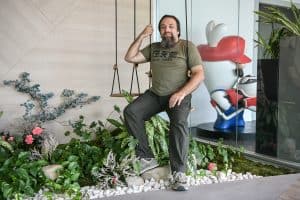Nintendo, like other media companies, is highly protective of its creations.
Only fellow Japanese studio Sega has been entrusted with characters from “Mario” before, for special editions games celebrating the Olympic Games where they compete with “Sonic the Hedgehog”.

“Nintendo told us very early on: ‘This is your game, this is your vision, we respect it,'” Ubisoft’s Xavier Manzanares, who is overseeing the new game’s development, told AFP.
“That’s where it’s interesting, so we had real creativity, really interesting room for maneuver.”
The first game in the series, “Mario + Rabbids: Kingdom Battle”, has garnered more than 10 million players since its release in 2017, said Manzanares.
“I don’t think we would have bet on that in 2017,” he said.
“It attracted a lot of attention because there are not many brands that do a pair-up with ‘Mario’, that’s for sure.”
A history of mash-ups
The idea of fictional universes colliding — characters from one popping up in another — is far more developed in cinema franchises and comic books than in video games.
Superheroes, for example, have a long history of showing up in a rival’s storylines.
In video games, Nintendo has created mash-ups featuring its own characters, like the “Super Smash Bros” series that brought together the likes of Pikachu, Donkey Kong and others.
Occasionally two studios join forces, like in the “Kingdom Hearts” series, which matched up “Final Fantasy” of the Japanese publisher Square Enix with characters owned by Disney.
This is much closer to the idea of Spiderman and Superman walking into each other’s storylines, as happened in 1970s crossover comics and many times since.
Julien Pillot, an economist specializing in cultural industries, told AFP this kind of collaboration in video games was rare and tricky to pull off.
Issues of rights and royalties cause headaches, he said, and the studio loaning its characters is likely to make onerous demands to ensure its brand is protected.
‘New universes’

Ubisoft, though, said it had been given real leeway, even to create new crossover characters in the form of “Sparks”.
They are star-shaped creatures combining “Rabbids” with “Lumas”, characters from the game “Super Mario Galaxy”.
“For us, it was important not to have ‘Rabbids’ on one side and ‘Mario’ on the other in two separate silos,” said Manzanares.
He said the aim was to “really to create a new universe with both”.
The French firm’s developers have been working across two principal locations in Milan and Paris with support from other studios in China, India and Montpellier in southern France.
Manzanares played down the challenges involved in such a creative endeavor being carried out across so many locations.
“We’ve been working like this for a long time, whether it’s on the games Far Cry’, ‘Assassin’s Creed’ or ‘Just Dance’,” he said.
Analyst Cedric Lagarrigue told AFP video game firms were increasingly working on global lines like this.
North America or Europe often leads on the creative part, he said, then processes like making 3D characters or environments, “can be done anywhere in the world”.
Manzanares said all Ubisoft’s locations had autonomy and each one brought something to the new game.
“We really worked on this merger,” he said.
“It’s been a big eight-year job” bringing the two games to the market.

